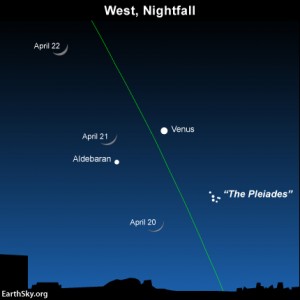
The moon sets in the early evening, leaving dark skies for the peak nights of the 2015 Lyrid meteor shower. The shower will likely be at its best in the dark hours before dawn on April 22 or 23, with the nod going to April 23. The green line depicts the ecliptic.
EarthSky’s annual fund-raising campaign is coming into the home stretch. Help EarthSky keep going!
The annual Lyrid meteor shower is active each year from about April 16 to 25. In 2015, the peak of this shower – which tends to come in a burst and usually lasts for less than a day – will fall on the mornings of April 22 or 23, with the nod going to the later date. The greatest number of meteors should fall during the few hours before dawn on either date. In 2015, a waxing crescent moon will set in the evening on the days around the Lyrids’ peak, leaving a dark for watching meteors. All in all … awesome Lyrid meteor shower prospects this year! Follow the links below to learn more about April’s shooting stars!
How many Lyrids meteors can I expect to see?
Where is the radiant point for the Lyrid meteor shower?
How to watch the Lyrid meteors.
Comet Thatcher is the source of the Lyrid meteors.
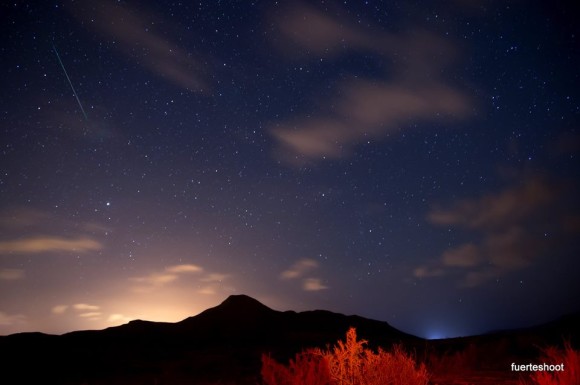
View larger. | Simon Waldram in the Canary Islands caught this Lyrid meteor on the night of April 20-21, 2014. Thank you, Simon!
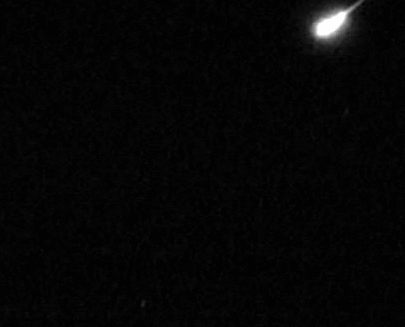
A fireball meteor falling earthward, courtesy of NASA/George Varros
How many Lyrids meteors can I expect to see? You might spot a Lyrid meteor anytime during the shower (April 16-25), but the most meteors will probably fall in the dark hours before dawn on April 23. The moon will be out of the way, and you might see from about 10 to 20 Lyrid meteors an hour at the shower’s peak.
Of course, meteor showers are notorious for defying the most careful predictions. The Lyrids stand as no exception. An outburst of Lyrid meteors is always a possibility (though no Lyrid outburst is predicted for 2015).
For instance, American observers saw an outburst of nearly 100 Lyrid meteors per hour in 1982. Around 100 meteors per hour were seen in Greece in 1922 and from Japan in 1945.
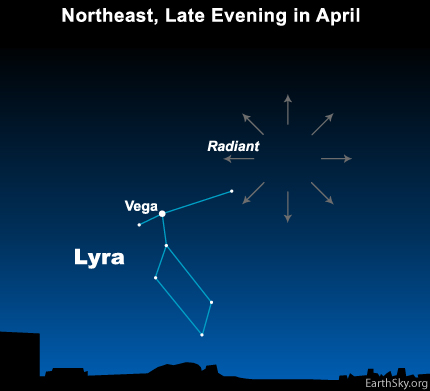
The radiant point of the Lyrid meteor shower is near the bright star Vega in the constellation Lyra the Harp.
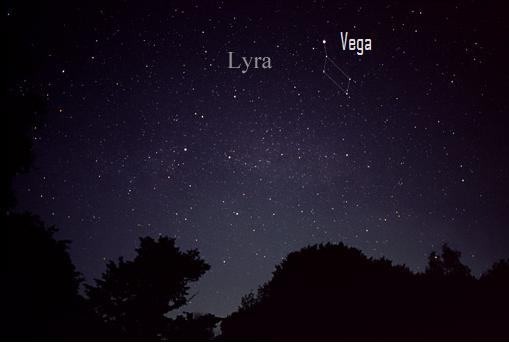
Another view of the brilliant star Vega, which nearly coincides with the radiant point of April’s Lyrid meteor shower. Image via AlltheSky
Where is the radiant point for the Lyrid meteor shower? If you trace the paths of all the Lyrid meteors backward, they seem to radiate from the constellation Lyra the Harp, near the brilliant star Vega. This is only a chance alignment, for these meteors burn up in the atmosphere about 100 kilometers – or 60 miles – up. Meanwhile, Vega lies trillions of times farther away at 25 light-years. Yet it’s from Vega’s constellation Lyra that the Lyrid meteor shower takes its name.
You don’t need to identify Vega or its constellation Lyra in order to watch the Lyrid meteor shower. The idea that you must recognize a meteor shower’s radiant point in order to see any meteors is completely false. Any meteors visible the sky often appear unexpectedly, in any and all parts of the sky.
However, knowing the rising time of the radiant point helps you know when the shower is best in your sky. The higher Vega climbs into the sky, the more meteors that you are likely to see. Be aware that the star Vega resides quite far north of the celestial equator, so for that reason the Lyrid meteor shower favors the Northern Hemisphere.
Around the Lyrids’ peak, the star Vega rises above your local horizon – in the northeast – around 9 to 10 p.m. local time (that’s the time on your clock, from Northern Hemisphere locations). It climbs upward through the night. By midnight, Vega is high enough in the sky that meteors radiating from her direction streak across your sky. Just before dawn, Vega and the radiant point shine high overhead. That’s one reason the meteors will be more numerous before dawn.

Portrait of Confucius.
Lyrid meteors in history. The Lyrid meteor shower has the distinction of being among the oldest of known meteor showers. Records of this shower go back for some 2,700 years.
The ancient Chinese are said to have observed the Lyrid meteors “falling like rain” in the year 687 BC.
That time period in ancient China, by the way, corresponds with what is called the Spring and Autumn Period (about 771 to 476 BC), which tradition associates with the Chinese teacher and philosopher Confucius, one of the first to espouse the principle: “Do not do to others what you do not want done to yourself.” I wonder if he saw the meteors …
How to watch the Lyrid meteors. Fortunately, you don’t need any special equipment to watch a meteor shower. Just find a dark, open sky away from artificial lights. Lie down comfortably on a reclining lawn chair, and look upward.
Another beautiful feature of the Lyrids to watch for … about one quarter of these swift meteors exhibit persistent trains – that is, ionized gas trails that glow for a few seconds after the meteor has passed.
Comet Thatcher is the source of the Lyrid meteors. Every year, in the later part of April, our planet Earth crosses the orbital path of Comet Thatcher (C/1861 G1), of which there are no photographs due to its roughly a 415-year orbit around the sun. Comet Thatcher last visited the inner solar system in 1861, before the photographic process became widespread. This comet isn’t expected to return until the year 2276.
Bits and pieces shed by this comet litter its orbit and bombard the Earth’s upper atmosphere at 177,000 kilometers (110,000 miles) per hour. The vaporizing debris streaks the nighttime with medium-fast Lyrid meteors.
If Earth passes through an unusually thick clump of comet rubble, an elevated number of meteors could be in store.
What was that date again? So heads up in late April! The Lyrids will probably be best between midnight and dawn on April 22 or 23, 2015, with the nod being given to April 23. The light of the waxing crescent moon won’t interfere, as it will set way before the peak hours of the Lyrid shower. If you’re out there with friends, a lawn chair to recline on, a sleeping bag to stay warm and thermos of something hot to drink … you’ll have fun.
Bottom line: The Lyrid meteor shower offers 10 to 20 meteors per hour at its peak on a moonless night. In 2015, the peak is the morning of April 22 or 23, with the nod going to April 23. A waxing crescent moon will set in the evening on the days around the Lyrids’ peak this year, leaving a dark for watching meteors. Like all meteor showers, the Lyrids aren’t altogether predictable. In rare instances, they can bombard the sky with up to nearly 100 meteors per hour. No Lyrid meteor storm is expected this year … but you never know.
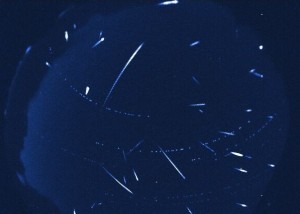
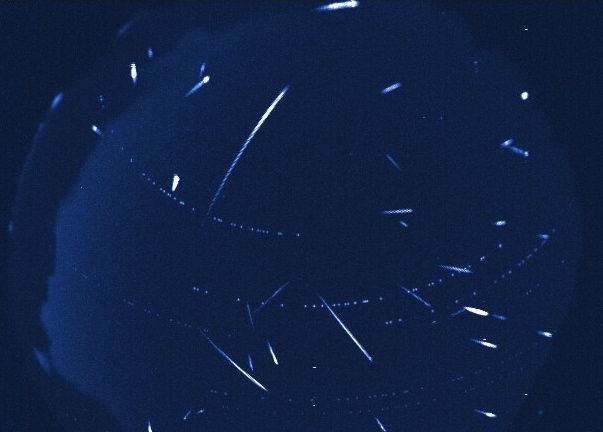
You need to be an initiate of Sky Watch to add comments!